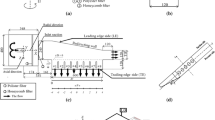Abstract
This paper presents the study of the influence of channel geometry on the flow structure and heat transfer, and also their correlations on all the walls of a radial cooling passage model of a gas turbine blade. The investigations focus on the heat transfer and aerodynamic measurements in the channel, which is an accurate representation of the configuration used in aeroengines. Correlations for the heat transfer coefficient and the pressure drop used in the design of internal cooling passages are often developed from simplified models. It is important to note that real engine passages do not have perfect rectangular cross sections, but include a corner fillets, ribs with fillet radii and a special orientation. Therefore, this work provides detailed fluid flow and heat transfer data for a model of radial cooling geometry which has very realistic features.
Similar content being viewed by others
References
Metzger D. E., Larson D. E., Use of Melting Point Surface Coating for Local Convection Heat Transfer Measurements in Rectangular Channel Flows with 90-deg Turns, ASME Journal of Heat Transfer, Vol. 108, pp. 48–54, (1986)
Kiml R., Mochizuki S., Murata A., Effects of Rib Arrangements on Heat Transfer and Flow Behavior in a Rectangular Rib-Roughened Passage: Application to Cooling of Gas Turbine Blade Trailing Edge, ASME Journal of Heat Transfer, Vol. 123, pp. 675–681, (2001)
Arts T., Benocci C., Rambaud P., Experimental and Numerical Investigation of Flow and Heat Transfer in a Ribbed Square Duct, 3rd International Symposium on Integrating CFD and Experiments in Aerodynamics, U.S. Air Force Academy, Colorado, (2007)
http://www.ericka.eu, (2009-2014)
Kaczynski P., Szwaba R., Doerffer P., Flaszynski P., Aerodynamic Enhancement in Inner Channel of Turbine Blade, Task Quarterly, Vol. 19, No 2, pp. 101–110 (2015)
Cakan, M., Aero-thermal Investigation of Fixed Rib-roughened Internal Cooling Passages, Ph.D. Thesis, Turbomachinery Department, Von Karman Institute for Fluid Dynamics, Brussels, (2000)
Irland P. T., Jones T. V., The Measurement of Local Heat Transfer Coefficients in Blade Cooling Geometries, AGARD Conference on Heat Transfer and Cooling in Gas Turbines, CP390 Paper 28, Bergen, (1985)
Jones T. V., Hippensteele S. A., High Resolution Heat Transfer Coefficient Maps Applicable to Compound Curve Surfaces Using Liquid Crystals in a Transient Wind Tunnel, NASA TM89855, (1988)
Vogel G., Graf A. B. A., Wolfersdorf J., Weigand B., A Novel Transient Heater-Foil Technique for Liquid Crystal Experiments on Film-Cooled Surfaces, ASME Journal of Turbomachinery, Vol. 125, pp. 529–537, (2003)
Clifford R. J., Jones T. V., Dunne S. D., Techniques for Obtaining Detailed Heat Transfer Coefficient Measurements within Gas Turbine Blade and Vane Cooling Passages, ASME Paper 83-GT-58, Arizona, USA, (1983)
Ireland, P.T., Neely, A.J., and Gillespie, D.R.H., Turbulent heat transfer measurements using liquid crystals, International Journal of Heat and Fluid Flow, Vol.: 20, Issue: 4, pp. 355–367, (1999)
Szwaba R., Kaczynski P., Doerffer P., Telega J., Flow Structure and Heat Exchange Analysis in Internal Cooling Channel of Gas Turbine Blade, Journal of Thermal Science, Vol.25, No.4, pp. 336–341, (2016)
Telega J., Doerffer P., Szwaba R., Kaczynski P., Parallelized Numerical Code For Derivation Of Heat Transfer Coefficient From Experimental Data, TASK Quarterly, Vol. 19, No. 2, pp. 197–205, (2015)
Acknowledgments
The research leading to these results has received funding from the European Union Seventh Framework Programme (FP7/2007-2013) under Grant Agreement No. 233799 (ERICKA). Permission for publication is gratefully acknowledged by the authors.
Author information
Authors and Affiliations
Corresponding author
Additional information
The research has received funding from the European Union Seventh Framework Programme (FP7/2007-2013) under Grant Agreement No. 233799 (ERICKA).
Rights and permissions
About this article
Cite this article
Szwaba, R., Kaczynski, P., Telega, J. et al. Influence of internal channel geometry of gas turbine blade on flow structure and heat transfer. J. Therm. Sci. 26, 514–522 (2017). https://doi.org/10.1007/s11630-017-0968-x
Received:
Published:
Issue Date:
DOI: https://doi.org/10.1007/s11630-017-0968-x




